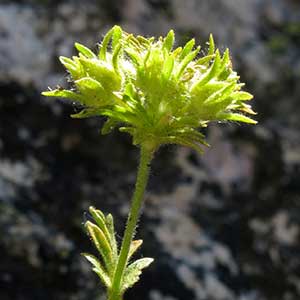Ivesia longibracteata
Ivesia campestris
Castle Crags ivesia, longbract mousetail
field ivesia, field mousetail, Kaweah ivesia
ascending to erect, 0.3–1.2 dm.
decumbent to ascending, 1–3.5 dm.
weakly planar to loosely ± cylindric, (0.5–)2–4(–6) cm; sheathing base glandular abaxially, otherwise glabrous;
petiole 0.5–2 cm, hairs 0.2–1 mm;
leaflets 5–6 per side, 2–6 mm, ± short-hirsute, glandular-puberulent, lobes 2–7, oblanceolate to spatulate or obovate, apex not setose.
(3–)5–15(–18) cm; sheathing base glabrous or sparsely strigose abaxially;
stipules ± lanceolate, 2.5–5 mm;
petiole (0.3–)0.5–6(–8) cm, hairs sparse to abundant, appressed-ascending, 1–2 mm;
leaflets 15–20 per side, loosely overlapping, 2–10 mm, lobes 2–5, oblanceolate, hairs sparse to abundant, spreading to ascending, 1–2 mm.
1–3, not paired.
3–4.
3–14-flowered, 1–2.5 cm diam.;
glomerules 1.
5–20(–40)-flowered, (1–)1.5–2.5(–4) cm diam., flowers arranged in 1–few ± tight glomerules of 10–15 flowers.
1.5–6 mm.
1–4 mm.
8–10 mm diam.;
epicalyx bractlets linear to narrowly lanceolate or elliptic, 2.5–5 mm, longer than sepals;
hypanthium shallowly cupulate, 0.5–1 × 2–3 mm;
sepals 1.5–2.5 mm, ± acute;
petals pale yellow, linear to narrowly oblanceolate, 1.5–2.5 mm;
stamens 5, filaments 0.7–1.3 mm, anthers yellow, 0.5–0.8 mm;
carpels 6–11, styles 1–1.5 mm.
7–10 mm diam.;
epicalyx bractlets linear to oblong, 1–2(–2.5) mm;
hypanthium campanulate, 1–2 × 2.5–4 mm, ± 1/2 as deep as wide;
sepals green, 2–3(–3.5) mm, acute;
petals 4(–5), light yellow, oblanceolate to spatulate or narrowly obovate, 3–4 mm;
stamens 12–16 (4-merous flowers) or 16–20 (5-merous flowers), filaments filiform, 0.6–1.1 mm, anthers yellowish, 0.3–0.5 mm;
carpels 4–20, styles 1.4–2 mm.
cream to light tan, 1.2–1.5 mm.
light brown, 1–1.5 mm.
Ivesia longibracteata
Ivesia campestris
Of conservation concern.
Ivesia longibracteata is known only from the Castle Crags area of Shasta County. The epithet alludes to a diagnostic characteristic unique in the genus: the epicalyx bractlets are longer than the sepals. The plants grow on vertical rock faces, a habitat more characteristic of sect. Setosae; however, the stems are ascending to erect and do not form hanging clumps, and the pedicels are not curved in fruit.
(Discussion copyrighted by Flora of North America; reprinted with permission.)
Ivesia campestris is found in the southern Sierra Nevada south of the Kings River, where it replaces I. unguiculata and often occurs at higher elevations.
Ivesia campestris is the only member of the genus that commonly has 4-merous flowers. It is sometimes misidentified as I. unguiculata, especially when the pale yellow petals have faded to creamy white; the glomerules of the inflorescences tend to be yellowish green to green rather than purplish. Also, the anthers of I. campestris are yellowish, rather than maroon.
(Discussion copyrighted by Flora of North America; reprinted with permission.)


